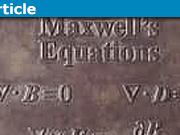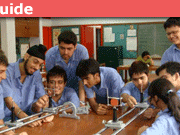Oral Presentations – Addendum | Physics Career
I’ll try not to make a habit out of this, but I believe there’s something to add to this chapter of the series.
In Part XIV, I mentioned the APS Meetings – March and April – which typically tend to be the largest yearly gathering of physicists. They both covered different areas of physics, i.e. different divisions under the APS wing would meet in March and in April. The March Meeting tends to be the condensed matter, material science, atomic/molecular physics, etc.. whereas the April Meeting covers particle, nuclear, astrophysics, etc. I have not attended the April Meeting, but I have attended the March Meeting numerous times and have given a talk at all but one of the meetings that I attended. Based on what I have been told, the April meeting, while smaller than the March Meeting, follows roughly the same format as the March meeting. So this description covers both.
The reason why I am going to spend time describing these conferences is that for most physics graduate students, one of these meetings will probably be the conference where they cut their teeth at presenting to people in their profession. Chances are, you will present your first-ever professional talk at one of these conferences. This is where you will meet your peers, the people you have cited in your work, the people you read about when you decided to go into your particular field, etc. And chances are, this will be the time you will start to be known not just from your name, but what you look like and how you interact. So rather than going into this blindly, it might be useful to know a bit more of what goes on at one of these meetings. Also, the March and April meetings are unlike other physics conferences due to their size. So if you have attended other conferences, don’t be surprised if the March/April meetings appear a lot different.
The March Meeting is HUGE. With an attendance of upwards of more than 5000, and with almost every attendee presenting, the scientific program itself used to be the size of 2 phonebooks! At any given time, at least 50 simultaneous sessions are going. So out in the lobby and in the hallway, it can be quite a zoo, but it is nevertheless well-controlled chaos, with people jumping in and out of one session into another.
If we neglect the special symposiums, there are 3 different categories of presentations at the March Meeting: (i) invited talk (ii) contributed talk (iii) poster session.
The invited talk is when you are invited by the organizing committee to present your work. This can occur either by someone nominating you to present your work, or someone in the committee notices an important work, usually in scientific journals, and would like you or someone on the author’s list, to present the work. This is a very prestigious honor (I strongly suggest you note this in your resume and if possible, save the invitation – trust me on this, you’ll thank me later). It means that your work was deemed important enough and deserves to be invited to give a presentation on it at such a major conference.
Now the invited talks can be presented in two types of sessions. Typically, you may lead off a smaller session of the same subject group and be given maybe 20 minutes. Other people that follow you are those giving contributed talks and have shorter time (more on this later). However, sometimes the conference committee may deem that a particular area or topic either deserves its plenary session or that they have sent out invitations to several people in the same subject area. In that case, a special plenary session in a large conference hall is held and each speaker is given a longer time to present their talk (typically 40 mins).
The contributed talk, on the other hand, can feel more like an automated, production-line presentation. The majority of the talks at this meeting are of this category. This is where you submit an abstract to the conference for an oral presentation, and then you are assigned to a particular session (usually with like-minded people in the same subject area). Everyone who registers for the conference CAN present a contributed talk. You have 10 minutes plus 2 minutes for question and answer before the next person comes up. So things move very fast and the time is strictly adhered to. This is because in the scientific program (the one that can be 2-phonebook thick) the time that such-and-such talk will occur in a particular conference room is listed. This allows people who are jumping from one session to the next to know when the such-and-such talk will commence. Running long will mess things up, and the chairperson has been instructed to be very strict with the timing.
[This brings up an unusual occurrence wherein the case that there’s a missing presenter, the next person after this presenter still cannot just walk up and do his/her presentation because that will throw off the timing. His/her presentation has been scheduled for a particular time, and if he/she goes early, someone who may have planned on being there at the start of his/her talk may miss it. So what ends up happening is that people just sit patiently in the room till it is time for the next presenter to begin. I have never seen this occur in other conferences.]
Note that just because it is a contributed session doesn’t mean the talk isn’t important. I think there’s a rule that if you received an invited talk one year, you cannot receive another one the following year (they want to make sure no single person monopolizes these things). There is still important work and results being presented in these talks.
The last type of presentation is the poster session. What you do here is present your work in a well-thought-of poster that you put up on boards. Depending on your subject matter, you will be assigned a location and a date for your poster to be put up. People wander through the poster hall continuously during the session, and you (or one of the people working in your group) should be by your poster throughout the session. This will allow people who have questions or comments to be able to talk to the people who are responsible for your work. You’d be surprised how much valuable information can be gathered from such conversations. It is also a good idea to attach to the poster board any publications that the poster is based on. Many people attach a large envelope containing copies of the paper for people to take if they wish. Again, it is a way to “advertise” your work. For most graduate students going to one of these meetings for the first time, they tend to be presenting posters, since it is less nerve-racking than doing an oral presentation. This will give them a flavor of one of these meetings so that next year, they’ll know what to expect when they present a talk.
It is my personal opinion that if you are a physics graduate student in an institution in the US, you should attend one of these meetings at least once. If your adviser does not bring it up, ask. At some point, you will have to produce original work for your PhD research, and this is what you should present at one of these meetings. It is your best chance to meet other physicists in your field. It is an opportunity not to be missed.
PhD Physics
Accelerator physics, photocathodes, field-enhancement. tunneling spectroscopy, superconductivity








Great advice Zapperz!